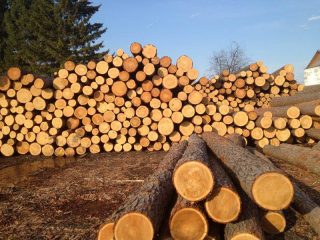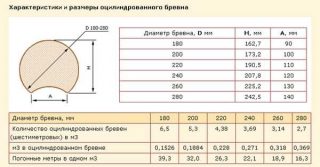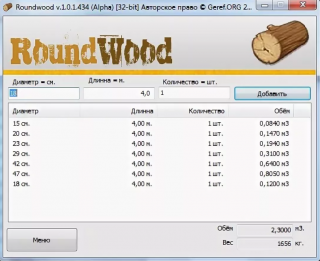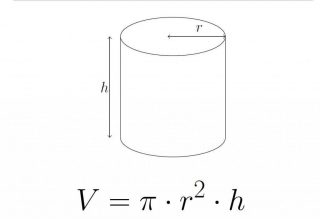The rounded log has exact dimensions, since it is made in the factory on high-quality equipment, the amount of manual work is very small. Standard dimensions of products allow you to calculate in advance the cubic capacity of a log in order to determine the consumption of material and make the necessary purchases.
Description and scope of application of rounded logs
Rounded sawn timber used for construction:
- log cabins of residential buildings;
- outbuildings on the site;
- small architectural forms in the form of gazebos, awnings, playground structures.
The correct shape of the products, precise fittings allow making a tight connection, while the speed of construction increases in comparison with bricks or blocks. At the factory, the material is treated with impregnations in the form of fire retardants and antiseptics to increase resistance to moisture, inflammation, mold and rot.
What is the calculation of cubic capacity for?
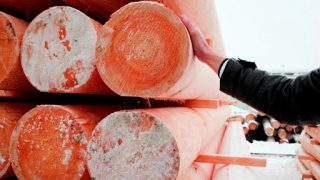
Cubic capacity means the volume of wood, expressed in cubic meters.
The value is used by specialists:
- for calculating the amount of round timber when erecting log cabins from rounded and unprocessed sawn timber;
- suppliers for the sale of timber at home;
- suppliers in the sale of firewood.
Payment for timber is made for each cubic meter, so you need to be able to calculate the number of logs in a cube. So you don't have to overpay for extra material. When calculating measure the perimeter of the structure, be sure to take into account the protrusions of the logs at the corners (paws).

Volume calculation methods
There are several ways to roughly calculate the cubic capacity of rounded logs. This requires the geometric dimensions of the building and mathematical formulas. The dimensions of the building materials are measured with a tape measure, and the dimensions of the house are taken according to the plan (project).
Builders, sellers and developers use multiple methodsto calculate the cubic capacity of the log:
- household way;
- using special tables;
- with data substitution in formulas;
- using an online calculator.

Domestic
Calculation procedure:
- take the diameter of lumber, usually take 26 cm;
- determine the height of the log house, more often the value is 2.4 - 3.0 meters per floor;
- calculate the number of logs for each wall, then add up the indicators;
- find similarly the number of logs for the interior walls.
Next, you need to find the volume of one element, then the resulting value is multiplied by the amount for the whole house. This is how the total volume of timber for purchase is found.
For different walls (inside and outside the building), different diameters of building materials will be required. The volume is considered for each type of elements (even if there are several of them), then the obtained values are added, and the total volume of the log per house is obtained.
Using tabular data
This is a simplified method, since half of the calculations do not have to be done. Use ready-made tables, which indicate data on the cubic capacity of various log elements. There are separate registers for rounded, chopped, unedged materials.

By formulas
Sometimes proven formulas are used for the calculation. One of these is used to find the cross-sectional area S = πr²where:
- π - standard number equal to 3.14;
- r Is the radius of the log squared.
For example, take a standard round log with a diameter of 240 mm, substitute the values in the formula: 3.14 · (0.12 m) 2 = 0.0452 m². The resulting value must be multiplied by the length of the log in the wall, taking into account the outlets at the intersection. This length, for example, is taken as 6 m.
Multiply: 0.0452 m² · 6 m = 0.27 m³. To find out the total volume of the log for the entire structure, multiply 0.27 m³ by the number of elements in the frame. For example, there were 50 of them, therefore 0.27 m³ · 50 pcs. = 13.5 m³.
Using a calculator
How to work with the online calculator:
- for a start, the overall dimensions of the structure (external walls) and the radius of the round timber are entered into the corresponding columns or windows;
- when arranging walls in a "bowl" or in a "paw", 0.5 m is added to the length of the element for accurate calculation; when assembling by the method, nothing is added to the "half-hook";
- the procedure for entering parameters is repeated for internal partitions and walls, taking into account that the section for these structures is already different.
After clicking the button for the calculation, data on the amount of the required forest appears.
Example
The example concerns calculation using tables. Determine the length of the outer walls, take into account the joining of the logs. The amount of round timber is taken in height in order to reach the desired level under the roof. Do not forget about the gables. Next, they are determined with the size of the transverse diameter of the lumber. It turns out 60 logs 6 m long, 220 mm in diameter.
Determination procedure:
- the value of the diameter is found in the table, and on the contrary, the value of the volume is tracked for a diameter of 220 mm, the resulting value is 0.0466 m³;
- multiply 0.0466 m³ by 6 m, get the volume of the whole log: 0.0466 · 6 = 0.28 m³;
- multiply the cubic capacity of the element by their total number: 0.28 m³ · 60 pcs. = 16.8 m³.
How to calculate the volume of one log
- S - cross-sectional area;
- d² - diameter squared;
- π - constant number equal to 3.14.
After finding the area, the result is multiplied by the length of the element, and its volume is obtained.
Sometimes the cubic capacity of a log needs to be known in order to calculate how many elements of such products are obtained in one cube. For this, 1 cubic meter is divided by the volume of one log. For example, 1: 0.28 m³, we get that there are 3.57 of them in a cubic meter (diameter 220 mm, length 6 m).

